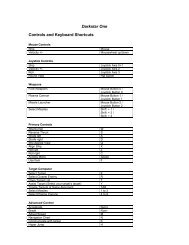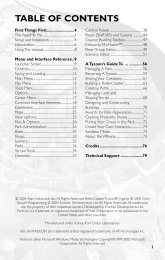Heads-Up Display Modes 35 - Metaboli
Heads-Up Display Modes 35 - Metaboli
Heads-Up Display Modes 35 - Metaboli
Create successful ePaper yourself
Turn your PDF publications into a flip-book with our unique Google optimized e-Paper software.
84 Air-to-Air Missiles<br />
execute a continuous turn, bleeding speed and energy all the while. The target<br />
may also turn away to place the missile at the beam position as well. In any event,<br />
the target is trying to make the missile expend as much energy as possible, which<br />
shortens its range and its maneuverability.<br />
Conclusion<br />
From this we see that “missile range” is a very complex topic. Merely knowing<br />
that a missile has a 30 km range doesn’t do much good… When fired from what<br />
altitude? When the target is at what altitude? Against what aspect angle? At what<br />
airspeed? Overall, we can draw two main conclusions:<br />
1. The closer you are to the target when you shoot, the better the chances that<br />
your missile will hit the target. Missiles fired at or near their maximum range<br />
(for the given circumstances) are not very likely to hit.<br />
2. Launching from higher airspeed and altitudes significantly increases the<br />
missile’s effective range.<br />
Missile Guidance<br />
The missile’s guidance systems provide input to the missile’s control system,<br />
which in turn maneuvers the missile to intercept the target. Most modern AAMs<br />
are based on homing guidance. When homing, the guidance law is formed in the<br />
missile’s computer using information on target motion. There are three types of<br />
homing: passive, semi-active, and active.<br />
The simplest of these types, passive homing, relies on emissions given off by the<br />
target itself (radio, heat, light, sound). In case of active and semi-active homing,<br />
the target is illuminated (usually by radar or laser), and the homing system guides<br />
on the illumination energy reflected off the target. For active homing guidance, the<br />
missile itself illuminates and tracks the target. Semi-active homing implies that<br />
some source external to the missile (for example, the radar of the launching<br />
platform) illuminates the target.<br />
Some missiles, especially long-range ones, use combined guidance: inertial radiocorrected<br />
guidance and homing on the terminal part of flight. To implement inertial<br />
guidance, the launching aircraft computer feeds into the missile’s control system<br />
information on target coordinates, trajectory, and relative speed.<br />
After the missile has started, its guidance system uses the information about the<br />
relative position of the missile and the interception point computed by the<br />
navigation system. During the flight of the missile, the interception point may<br />
significantly change. For this reason, radio correction supplements the inertial<br />
guidance. This increases the accuracy with which the missile reaches the target<br />
area. <strong>Up</strong>on approaching the target, the guidance system switches to homing,<br />
passive or active.<br />
To home, a missile needs a device that will receive radiation from a target (sense<br />
it) and track the target. This device, known as a seeker, is located in the nose of<br />
the missile. However, semi-active homers may include a rear receiver for<br />
reception of information from the illuminating platform. Active homers contain a<br />
transmitter and receiver generally located forward. Depending on the type of<br />
radiation received by the missile, the seeker may use infrared or radar.















